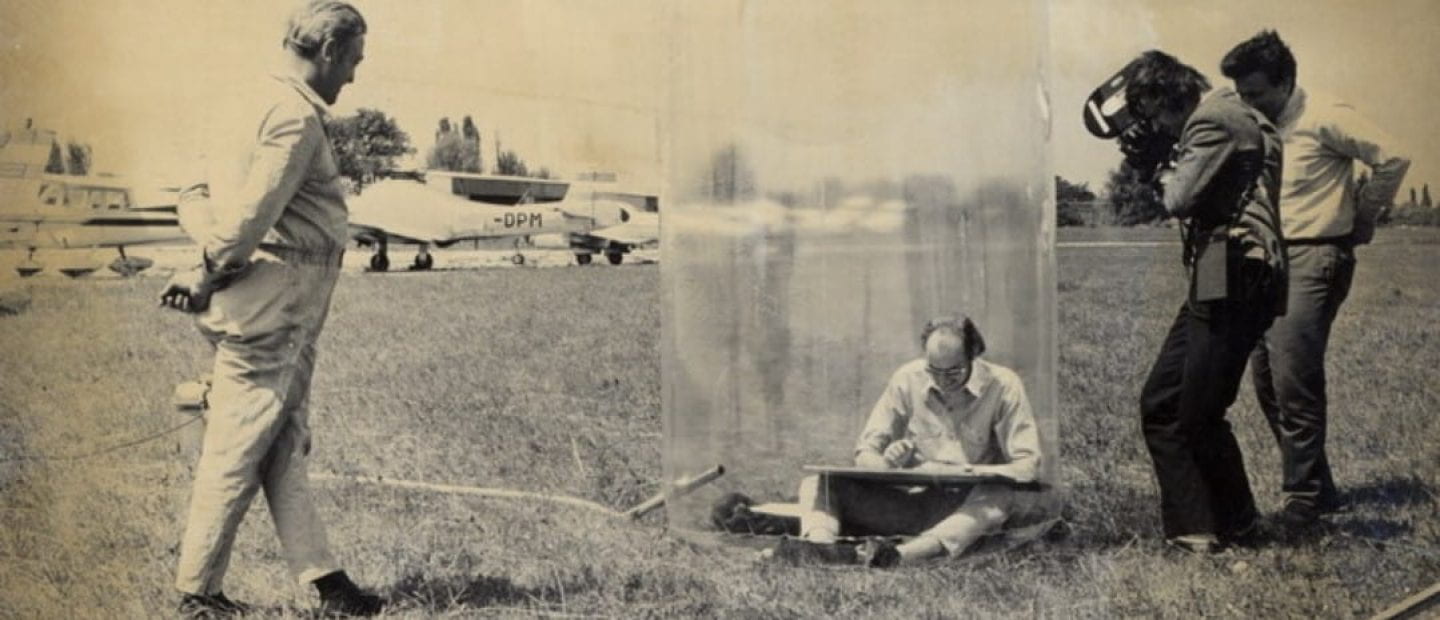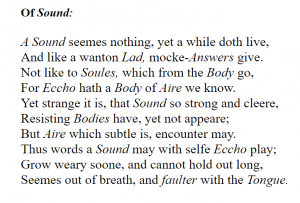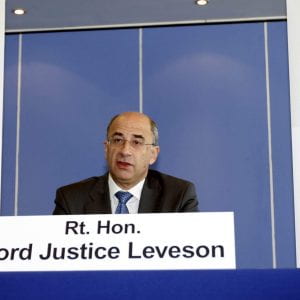Amplification in Rebecca Belmore’s Ayum-ee-aawach Oomama-mowan: Speaking to Their Mother
I’m taking the opportunity of this short text to introduce a sculptural installation by Anishinaabe artist Rebecca Belmore into the ongoing discourse of our class. Ayum-ee-aawach Oomama-mowan: Speaking to Their Mother (1991) is a six-foot wide megaphone that Belmore built from wood and animal hide. Throughout the five years following its initial construction, the artwork was transported to, and reassembled at, several different locations, including numerous Indigenous communities. In photographs documenting Belmore’s ambulatory sculpture, we see bodies gathered around the honeycomb latticework of the megaphone’s frame, and a 1992 video from the Wiggins Bay Blockade shows an intergenerational group examining the piece, circling from end to end while testing out its sonorous possibilities.
Speaking in this video, Belmore explains that her initial impulse for the project was to “stage the ultimate protest on Parliament Hill. I wanted to break the windows, cause they don’t listen” (Beaucage and Belmore 1992). After further reflection, however, Belmore recounts that her intended audience shifted. She decided to take her sculpture “out to the people, to Native people, and turn it towards the land so that the people could speak to our mother, to the earth” (Beaucage and Belmore 1992).
While Belmore’s work proposes many aesthetic and conceptual interventions, I want to focus on what this sculpture does with amplification, as a sonic phenomenon, artistic tool, and political operation. The distinct acoustic process of amplification is essential to the form and implications of Belmore’s sculpture. At its most basic, to amplify is to “augment in volume or amount” (“amplify, v.” 2020), and a megaphone uses the physics of how sound waves behave in spatial transitions to achieve this effect. When sound is projected from an enclosed space – such as a mouth – to a much wider one – the open air – this drastic shift will actually cause a significant portion of the emitted sound waves to bounce backward, toward the point of origin. When we speak unassisted, much of our voice actually ricochets back into our mouths. A conical horn helps avoid such a sudden transition – sound waves moving from a mouth into the similarly circumscribed opening of a horn will continue moving forward, instead of bouncing back. If the horn is constructed not as a smooth cone, but rather with an exponential curve, the amplification effect is most efficient, as the sound waves stretch evenly and gradually (Crowhurst 2010). What I find particularly evocative here is not merely that an exponentially curved horn makes voices louder, but that it does so specifically by helping a greater proportion of articulated sound waves travel out of the body.
Belmore built her sculpture with precisely this exponential curve. The assembled wooden structure fans outward, and painted animal hides smooth over the seams where its segments meet, creating an acoustically ideal smooth, even surface. And while the piece was sometimes installed with an added electronic bullhorn to push the effect of amplification even further, the structure itself – with or without adornments – employs the most efficient shape for carrying voices far afield. The installation’s physical qualities, then, serve what I propose is a fundamental element of the project’s conceptual operation. We might understand Speaking to Their Mother as materializing something akin to what Adriana Cavarero tries to articulate through the canon of Western philosophy: that is, the value of the unique embodied voice. Belmore’s megaphone enhances the speech act not through semantic means, but by preventing the losses that accompany unmediated sonic transmission. The megaphone’s acoustic efficiency allows more of the individual’s physically produced sound – their singular, fleshy voice – to exit into the air, the public, the surrounding ecology of earth. The voice, here, feels like a precious resource: not to be wasted, to be meticulously carried forth for all the distinct potential it offers.
This valuation has a particular resonance in the political context of Belmore’s project. I don’t have space here to discuss the events of the 1990 Oka Crisis at any length, but at a moment when the Canadian nation’s flagrant disregard for Indigenous land claims, violent repression of Indigenous sovereignty, and total repudiation of good relations were so viscerally felt, the valuation of Indigneous voices that Belmore’s sculpture enacts feels like an especially potent intervention.
Describing Speaking to Their Mother, Belmore writes, “Asking people to address the land directly was an attempt to hear political protest as poetic action” (Beaucage and Belmore 1992). What does Belmore mean by poetic action? I think what is at work here is an idea of the poetic not as a specific type of utterance, but as any utterance offered with a specific directionality or orientation; in this case, an ecological one. Belmore’s statement helps us to understand how her work expands existing conceptions of both poetic and political speech. In the artist’s formulation, the direction of a speech act toward the land yolks together the political and the poetic, and this expands the range of both. In his “Translator’s Introduction” to Cavarero’s For More than One Voice, Paul A. Kottman (2005, viii) summarizes: “Cavarero locates the political sense of speech in the singularity of the speaker’s voice, the acoustic emission that emits from mouth to ear.” Belmore’s sculpture expands the scope of such a transmission, from a corporeal linking, to something like an ecological networking. Here, embodied voice carries from the throat to the mouth to the land: an ecological entity that includes the many ears, human and not, that it sustains. Similarly, Belmore’s sculpture insists on poetics as a practice that comprises speaking and listening, to and with materially inhabited space. The explicit relationality of this model operates not only in how Belmore’s artwork invites ecologically-oriented speech, but also in the grammatical fabric of the language some participants would have deployed in their speech acts with the sculpture. Anishinaabemowin’s classification of nouns between animate and inanimate categories suggests an approach to rendering one’s surroundings as comprising a multiplicity of agencies, enmeshed with, yet irreducible to, the human (Carter 2016). This may offer an alternate perspective to the potential solipsism of the internally-tuned poetic ear that Charles Olsen prioritizes in his notion of projective verse (Olsen 1950). Belmore’s sculptural installation performs practices of political protest and poetic action that value the unique materiality of the voice, while always understanding each voice’s imbrication with a complex, and inherently relational ecological terrain.
Works Cited
“amplify, v.” OED Online. September 2020. Oxford University Press. accessed October 30, 2020. https://www-oed-com.proxy.uchicago.edu/view/Entry/6745?redirectedFrom=amplify.
Beaucage, Marjorie and Rebecca Belmore. Speaking to Their Mother. 1991; Winnipeg; Video Pool Media Arts Centre. Shooting format unlisted. accessed October 30, 2020. https://vimeo.com/99999913.
Carter, Jill. “Base Layers.” If This is Your Land, Where Are Your Stories: Spatial Dramaturgy and Indigenous Performance. Seminar at University of Toronto, January 19, 2016.
Crowhurst, N.H. “Horn Shapes.” in Basic Audio. Pressbaum, Austria: Virtual Institute of Applied Science, 2010. accessed October 30, 2020. http://www.vias.org/crowhurstba/crowhurst_basic_audio_vol1_049.html.
Kottman, Paul A. “Translator’s Introduction.” in For More than One Voice: Toward a Philosophy of Vocal Expression by Adriana Cavarero, vii-xxv. Stanford: Stanford University Press, 2005.
Charles Olsen. “Projective Verse.” 1950. accessed October 30, 2020. http://writing.upenn.edu/~taransky/Projective_Verse.pdf




Leave a Reply
You must be logged in to post a comment.